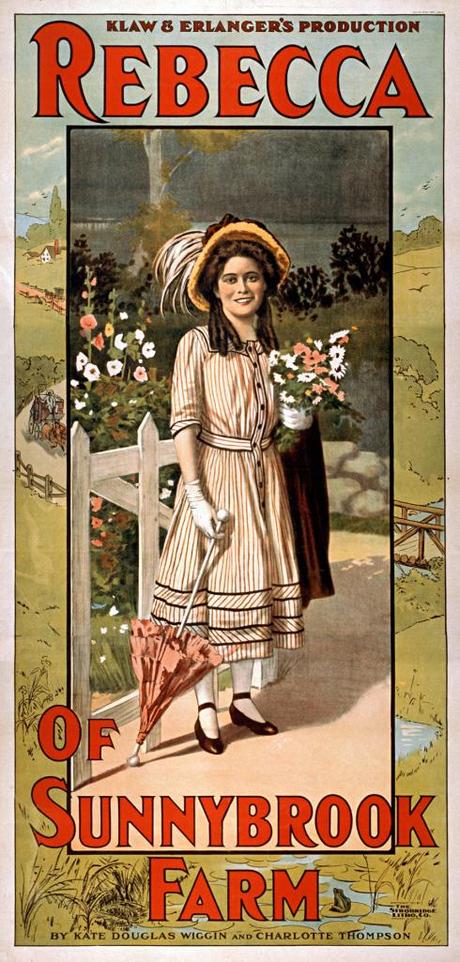
Rebecca of Sunnybrook Farm is one of those childhood classics, like Anne of Green Gables, that managed to pass me by when I was young. I was obviously too busy inhaling the terribly addictive Babysitters’ Club series to take in anything more edifying, and as such, I missed the chance to meet yet another remarkable heroine who might have taught me more than just how to make a bit of cash on the side after school. It’s interesting, when you dig around in the archives of 19th and early 20th century children’s novels written for girls, just how many women were anxious to provide a different narrative to the expected one of marriage and motherhood. L M Montgomery’s Anne and Emily, Louisa May Alcott’s Jo, Gene Stratton Porter’s Elnora, and now Kate Douglas Wiggin’s Rebecca are all girls whose desire is not for a man and a kitchen of their own, but a good education and opportunities for personal fulfilment. I wonder what impact this had on the girls who read these novels when they first came out; no doubt they had access to a variety of fairy and adventure stories, and did not suffer as much from being beaten around the head by Christian moralising as the previous generation, but did they find these stories unusual or revolutionary in any way? Were they inspired by them, or were they frustrated by them, especially those girls who could not have hoped for access to the education and opportunities for creative fulfilment they were reading about? I’d love to know more.
Rebecca is cut from the same cloth as L M Montgomery’s heroines; an irrepressible little thing, with a mouth that won’t stop moving and a fanciful, romantic spirit, she is sent away to live with two spinster aunts after her father dies and her mother can no longer afford to keep seven children. Aunt Miranda and Aunt Jane live in the ‘brick house’ in Riverboro, Maine, where they are pillars of their small community. Aunt Miranda is hard hearted and a stickler for rules and neatness; she has no desire to take Rebecca into her home, and only does so out of duty towards the younger sister she blames thoroughly for her own misfortune, having married a feckless drifter she knew full well would come to nothing. Aunt Jane is Miranda’s opposite; sweet, kind and docile, she is thrilled at Rebecca’s arrival and does her best to lessen the harshness of Aunt Miranda’s regime and make Rebecca happy.
Rebecca, despite missing her beloved ‘Sunnybrook farm’ is keen to please, and tries her best to do right by her aunts, often with the hilarious consequences one would expect of a girl who just can’t help herself from getting into trouble. The plot of the novel revolves around Rebecca’s friendships with a number of locals, from the elderly, childless Cobbs, for whom Rebecca becomes a surrogate granddaughter, to Emma Jane, the dull but pretty blacksmith’s daughter, who follows Rebecca everywhere. Life is full of the small pleasures, excitements and victories of childhood, and Rebecca brings a delight and a glory to the previously narrow lives of Riverboro’s young people. One of her greatest achievements is in selling enough soap to win a poor family a lamp, in the doing of which she meets a local young philanthropist, Adam Ladd, who becomes her ‘Mr Aladdin’ and will go on to support her through her high school days in neighbouring Wareham, where the world becomes even bigger for the ambitious and talented Rebecca.
It is a charming book, if not a little heavy handed in places, and Rebecca is an absolutely adorable heroine, who is a perfect example of how to make the best of a bad job in all situations. I very much like Douglas Wiggin’s attitude that the innocent goodness of children can bring about change in even the hardest of hearts, and I loved the ending, thinking it a wonderful example of feminism in action. In fact, there is much of Rebecca of Sunnybrook Farm that is echoed in Anne of Green Gables; such was its popularity when it came out, L M Montgomery must have read it and been influenced by it, because the similarities are striking. It is not as enchanting as its successor, but it certainly is worth reading nonetheless. I am delighted that Hesperus Press are continuing to republish such fantastic examples of classic children’s literature, and I can’t recommend it highly enough!
